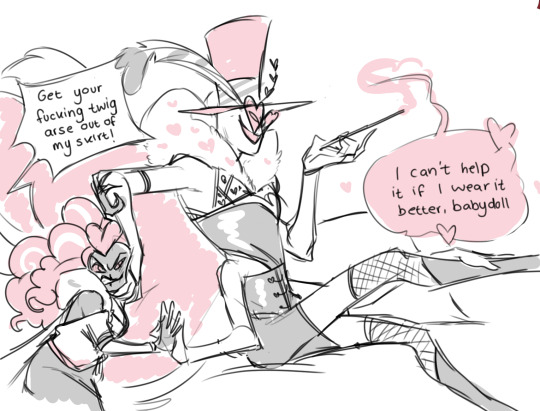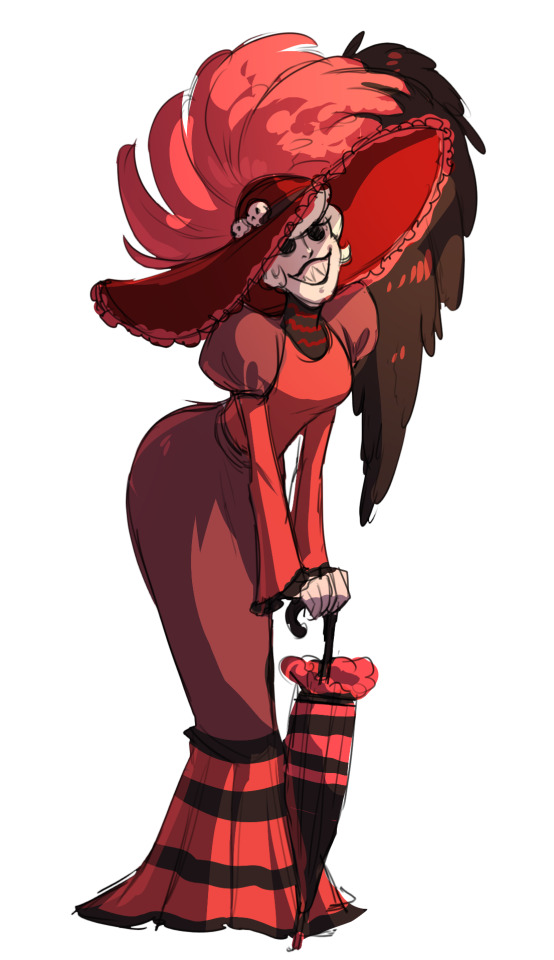#i need to draw them together but the vees are a polycule who make each other's lives worse
Text




Hazbin Hotel is a mess, pacing-wise, but I missed a good animated musical with just the Worst People so here are some of my Worsties :D
#hazbin hotel#sir pentious#rosie#velvette#valentino#carmilla carmine#sketches#i need to draw them together but the vees are a polycule who make each other's lives worse#alastor being aroace instantly makes him so much funnier#he's great#and charlie is a sweetie#i am struggling with the earless/noseless style#i just cave and add them
4K notes
·
View notes
Text
Polyamory writing tropes
Because I forgot that tumblr dot hell’s solution to spam bots is straight up hiding replies with too many links, here is a manual repost of my certainly incomplete list of polyamory tropes.
(I had originally posted it as a reply to an ask that was posted to @writingquestionsanswered - you should check them out!)
I will assume that A is into B, B is into A and C, and C is into B. B and A are not into each other. Furthermore, I will assume that everyone has agreed to being part of the arrangement as described. If B is dating A behind C’s back, that’s not polyamory, that’s cheating.
This constellation is commonly called a V or vee, because if you draw it, it kinda looks like a V. The partner “in the middle” B is called the hinge.
A and C are metamours to each other (meta + amour). They share a partner.
The most common trope with polyamory is the topic of jealousy. In fact, you will be hard pressed to find a story which does not focus on it, to the point that I would say it has been done to death, plus you can find plenty of guides how to write it, so I am not going to focus on that.
Instead, there are other interesting tropes specific to polyamory you can use:
Compersion is a word for a warm feeling of fuzziness you get when your metamour makes your partner happy. Imagine that, like, I am A, and B is really into underwater basket weaving. I, on the other hand, do not care for underwater basket weaving at all, and while I can empathize with B’s enthusiasm for it, ultimately I am not a good person to discuss underwater basket weaving with. But then, one day, B meets C! And C is also into underwater basket weaving! Now B can discuss water currents and sprig flexibility with C and is elated! And B being happy with C makes me happy! (In fact, it may be that I was getting a bit tired of the topic, so it benefits me as well. Cue crisis about whether I am a good person or if “dropping” B on C is selfish! So much delightful angst potential!)
One side effect might be that when B is out on a date with C, I finally have time for myself and my favorite hobby of chocolate teapot sculpting, which B somehow never seems interested in :/
Of course, depending on the person, this feeling might extend to more intimate topics and activities. It does not have to be limited to things A does not enjoy – A might just be happy that B has an additional person to do these things with.
However, it can also lead to establishing new couple activities. The common cliché is of the polyamorous person who is fine with their partner having sex with someone else – but don’t you dare watching “our” Netflix series with someone else.
The flip side of this is B being happy when A and C get along. As far as I know, we don’t have a specific word for that (we really should, though).
When metamours get along, they might delight in scheming to do something nice for their hinge together. For example, they might plan a surprise birthday party for B together (cue all shenanigans associated with surprise party and birthday party). They might also become great friends and share vulnerabilities with each other that they don’t even share with their mutual partner.
A might have actively pushed B to get with C. In this case, feel free to pull all the ShipperOnDeck tropes.
A and C might have felt apprehension towards meeting each other. B might have felt apprehension towards them meeting each other. What if they don’t get along!? You can borrow from the “meeting the parents” tropes here.
A and C might also get together over time. This might cause unexpected jealousy in B because of the change in relationship dynamics. It can be all the anxiety you get when your partner has a new partner… but multiplied by the fact you get it from both sides.
Incidentally, polyamorous people get to observe this “my loved one is freshly in love” theme often enough we have our own name for that “I have butterflies in the stomach and the world is made of gingerbread rainbows” feeling B gets – NRE or New Relationship Energy.
Ideally, A, B and C have all discussed what their relationship dynamics are to be. For example, whether it is okay to take on other partners or if there is the expectancy that A and C will remain exclusive to B. Also, if B is allowed to start further relationships with D, E and so on. (If it is to stay at the A/B/C constellation, it is called a closed relationship or possibly a closed triad.) And they hopefully have discussed how much everyone wants to know about the details of the other relationship and how much they get to know. They also have hopefully discussed how out they are to their social circles. (If people have conflicting needs on that, there may be some tension.)
In practice, I believe the most common setup is not a closed relationship (I have only personal anecdotes, though). It is more commonly like this (listed are everyone’s partners):
A: B
B: C, D
C: B, E
D: B, F
E: C
F: D
The set of all people in this network is called a polycule (a portmanteau of poly and molecule). In the above scenario, F might not even know about E. F is with D, D is with B, B is with C, C is with E. If this was a familial relationship, they would be something akin to distant cousins, with comparable dynamics – they might find it an amusing bit of trivia, but ultimately it doesn’t affect their lives much. They might, however, be in the same circle of friends, or even roommates. Which leads to amusing shenanigans like
B: C, I know you are visiting E [your partner] and F tonight?
C: Yeah?
B: D asked me to pass along this thing F forgot at D’s place [because D and F are partners]. Could you give it to F [because you are visiting F’s roommate]?
C: I think F is not at home tonight, but I will give the thing to E!
This can be somewhat confusing to the reader, because it gets you a large cast. If you ever find out how to solve this, let me know.
Also, Long Distance Relationships. So many Long Distance Relationships.
Of course, there are some people who will go to great lengths to chart their polycule, with the same diligence someone might employ while researching their ancestry.
Because marrying multiple people is not possible in most places, people may employ a similar ritual for a particular partner. Their are hand-fastening ceremonies, for example. Or other rituals - I know a person who texts all of their partners goodnight before going to bed.
There are some clichés about the polyamorous community. Polyamory is said to enable you to always have a group ready for board game night, for example. Or Dungeons and Dragons night – I reference this in my most shared post which apparently people can relate to.
Also, we are really good at scheduling. Shared calendars are frequently employed.
And we really talk a lot about our feelings. Which is… somewhat inconvenient for writing drama.
And we love large beds. Some of us don’t. (I feel too hot with even one other person in the bed. How some people deal with three is an utter mystery to me).
If you have made it this far, congrats! Thanks for researching our community! Seconding the recommendation for @polyamorouscultureis for more.
If you wish to check out my blog, you will find a list of helpful resources, and will get a mix of
me assuring people they are valid like this
polyamory memes like this
polyamory shitposts disguised as facts (which are not to be taken seriously for the purposes of research) like this
and general polyamorous tomfoolery.
#writing advice#polyamory#multi shipping#ethical non monogamy#polyamory representation#tunglr dot hell#I almost spent more time recreating the formatting of the original post than writing the guide in the first place#will put in resources
140 notes
·
View notes